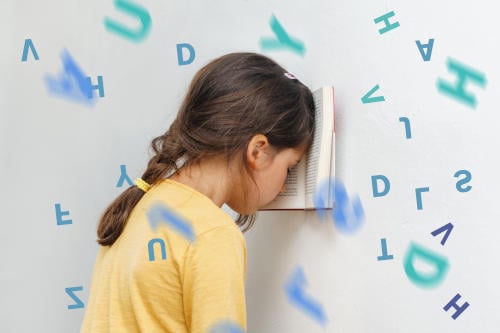It is estimated by the British Dyslexia Association that 10% of people in the UK have dyslexia. From this statistic, 4% of the population are extremely impacted by their reading and/or writing challenges.
Dyslexia is a neurological condition that can present itself in a variety of ways. For instance, a child may say that when they look at a text, it feels like the words are moving. If the words are moving, where should they be looking, and what should they be reading?
Attaining a diagnosis of dyslexia for your child may not always be a straightforward route. Costs may be involved which families will need to consider. There may be periods of waiting required, depending on the Local Authority, and varying levels of support depending on your child’s school. Some will be eventually classified as dyslexic and may be granted an EHCP. Others, although diagnosed dyslexic, may not be in receipt of an EHCP, due to the lesser severity of their symptoms.
As such, it is important to spot all schoolchildren with one or more dyslexic traits as early as possible and look towards finding an accessible plan that works for them.
What Are The Signs Of Dyslexia?

The truth is that each dyslexic young person may paint a different picture of their experience. Some of the regular indicators include:
- Reading/writing slowly
- A reluctance to read aloud
- Reading aloud inaccurately
- Disordered handwriting
- Inaccurate spelling
- Difficulty distinguishing between two similar letters, such as “b” and “d”
- A struggle to recall sequences or follow directions
- Challenges with the grasp of an audible text
This list is by no means conclusive.
Misconceptions

In our present SEND world, do we now have a proper understanding of what children with a diagnosis of dyslexia need? Or even if they haven’t been diagnosed, do we as educators know what to look for, so we can spot any dyslexic-related red flags, and give them the right help?
Can dyslexic children have a positive journey in school, and go on to achieve as well as their non-dyslexic peers? There may be some popular misconceptions about people with dyslexia, and what they may be likely to achieve.
If we consider the brilliance of dyslexics such as Einstein, Agatha Christie, and more recently actors such as Anthony Hopkins and Keira Knightly, there seems to be a clear message that having this challenge does not need to hold you back.
Experiences At School

If a child’s dyslexia is fully embraced in school it can have an overwhelmingly positive impact on their educational development.
Parents and carers of a SEND child will often have to fight to represent their child’s needs, leaving no stone unturned as they ensure their child unlocks their full potential. Not all children will have a diagnosis, so it is imperative to know the traits to guarantee that all children can be reached. Teachers will frequently encounter children each week with dyslexic traits, but what is the best way forward to help those children?
Jo is mum to Sarah, whose dyslexia was highlighted by her primary school at an early age. Recounting her experience, Jo recalls, “I would highly recommend that when searching for a school, particularly if you are already aware that there may be struggles with your child’s reading and/or writing, find a school with a strong SEND department. Meet the SENCO; talk to them about your child’s needs and see what they can offer.”
Jo continues, “As a parent, I was very supported by my daughter’s school. They understood her situation from the start of her journey and were able to offer excellent advice at each stage of her schooling. For example, they advised me to take Sarah to visit an optician who understood the condition.”
Whilst an optician cannot diagnose dyslexia, they are able to identify visual problems that can impact on their reading ability. Jo testifies, “An optician that has a grasp on dyslexia may offer some practical advice to assist your child’s reading experience. Sarah’s optician gave her a plastic film with a yellow tint, to be applied over a text to assist with her reading. She was additionally given some glasses with a similar colour and was advised to use whichever prop was more practically appropriate. The actual shade of the tint was apparently crucial, as I learnt that different colours provide variable impacts, depending on the need of the child.”
Jo adds, “It was a huge step forward to have this in place; it helped her confidence with reading and lifted her whole experience as she went through school.”
Learning At School With Dyslexia

Learning can be a joy to some and sometimes feels like a real burden to others. Material will be more accessible to dyslexic children if presented with information that reduces their need to read and write. If this pressure is lessened, children are more able to open their channels and absorb the stream of knowledge that they are expected to know, but that sometimes feels so unreachable.
Jo believes that the following inclusions can make a world of difference to a child with dyslexic tendencies: “Techniques used during a phonics lesson that familiarised her with letter strings and sounds, facilitated her skills by allowing her to blend, and then to read. As she progressed each year, she was allowed extra time in tests with the option to answer verbally. This removed a lot of pressure for my daughter.”
“Sarah’s school understood her needs; they understood her experience of dyslexia, how it represented itself, and they knew how to help her with her specific version of the condition.”
“She frequently had access to being taught in a small group. This was invaluable and gave my daughter space to explore her challenges freely.”
“Outside of the classroom, my experience communicating with Sarah’s teachers was always free flow and continuous. The school kept me fully informed of her progress. It always felt like they had a solid knowledge, not just of dyslexia, but of all neurodivergent issues.”
Other Useful School Strategies

There are other useful approaches that a school can adopt to help a child with dyslexic leanings. Seating a child near the front of the class is helpful, so they can see their teacher and interpret any non-verbal cues.
Signs, flashcards, sequence boards and other pictorial resources can be extremely helpful. The use of videos is a welcome gateway for children with reading or writing concerns, offering more joy from learning, away from the constant need to read. The adaptation of worksheets can be uplifting, creating more of a visual impact, with less wording to unravel.
Other beneficial steps a school can take for dyslexic children is to:
- Ensure they have an order to their work, so it can be easily filed and accessed
- Allow access to audio learning resources, to present an alternative to interpreting a text
- Provide laptops, with the added availability of tasks in the spoken word alongside a text
A Look At The Bright Side

It helps enormously for schools to be aware that dyslexic children often show a creative streak, with a great capacity to recall past experiences and factor it into a fantasy realm. They may convey artistic talents with a zest that allows them to produce paintings, models, cartoons or animations. Their work can portray vibrant interpretations of colour, and show a deep empathy towards others, with a sensitivity towards more vulnerable groups, the victims of a historical era or a current news topic that arises.
In addition, a desire to solve problems is often noted in such children. They may be more likely to excel in a virtual world, remembering computerised environments and what lies within them. Their memories can often serve them well elsewhere as they may show a high level of ability to retell a story, recounting many of the finer details many may forget.
By focusing on these many potential attributes, a school can help a dyslexic child flourish in all lanes of their learning experience, boosting their confidence and self-assurance.
When children with a tendency towards dyslexia attend a school that understands their way of learning, it will open their minds to new possibilities. It will feel less like a bumpy road of potholes, and more like a smooth runway, where they can access a fully-rounded education.
With Dyslexia Awareness Week approaching on 7th-13th October, we hope that our dyslexic community thrive as they move forward in an environment where a positive awareness and an understanding of this condition continues to grow.




